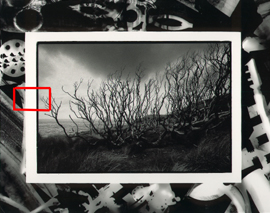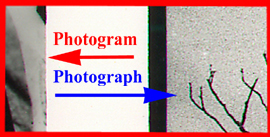Resolution
of a photogram
Unlike
the traditional photographic process, where a photographic negative
is enlarged, the photogram is usually a contact print, where the information
is printed directly from the original matrix to the light sensitive
paper at a ratio of 1:1. Because of this, photograms have exquisite
resolution and detail - there is no film grain.
However
good a film is, it only has the ability to resolve a certain amount
of information per square cm. A frame of 35
mm film for instance is enlarged about 58 times to make a 8x10 print
and the grain of the film which has recorded the tonal variations of
the subject is also enlarged. This is why many photographs look grainy.
A 8x10 photogram on the other hand only has the very fine grain of the
paper, which is unperceivable to the naked eye, to inhibit the clarity
of the image.
A
photogram made on 10x8 inch paper for example will show a much greater
resolution than an 8 X10 Inch print from a 35mm negative - any fine
lines and textures contained in the object can be revealed by the process.
| This
work is an example of a combination photogram/photograph
from the Codes
of Survival project. The central image is from a 35
mm frame while the photogram border is a contact print. |
|
 |
The section on the right is an enlargement of the area with the
red line around it and demonstrates the difference in grain
between the photograph and the photogram. |
|

|
|
| |